Sagitta constellation lies in the northern sky. Its name means “the arrow” in Latin.
Sagitta is one of the Greek constellations. It was first catalogued by the Greek astronomer Ptolemy in the 2nd century. It represents Heracles’ arrow in Greek mythology.
Sagitta is the third smallest constellation in the sky. It has no stars brighter than fourth magnitude and contains few notable deep sky objects. These include the globular cluster Messier 71 (NGC 6838) and the Necklace Nebula, a planetary nebula discovered in 2005.
Facts, location and map
Sagitta is the 86th constellation in size, occupying an area of only 80 square degrees. The only constellations smaller than Sagitta are Equuleus and Crux.
Sagitta lies in the fourth quadrant of the northern hemisphere (NQ4) and can be seen at latitudes between +90° and -70°, from every location on Earth except the Antarctic Circle. The neighboring constellations are Aquila, Delphinus, Hercules and Vulpecula.
The constellation name Sagitta is pronounced /səˈdʒɪtə/. In English, the constellation is known as the Arrow. The genitive form of Sagitta, used in star names, is Sagittae (pronunciation: /səˈdʒɪtiː/). The three-letter abbreviation, adopted by the International Astronomical Union (IAU) in 1922, is Sge.
Sagitta belongs to the Hercules family of constellations, along with Aquila, Ara, Centaurus, Corona Australis, Corvus, Crater, Crux, Cygnus, Hercules, Hydra, Lupus, Lyra, Ophiuchus, Scutum, Sextans, Serpens, Triangulum Australe and Vulpecula.
Sagitta contains one Messier object, the globular cluster Messier 71 (M71, NGC 6838). There are no meteor showers associated with the constellation.
Sagitta contains three formally named stars. The star names approved by the International Astronomical Union (IAU) are Sham, Uruk, and Sansuna.
Sagitta does not have any stars brighter than magnitude 3.00 and contains only one star located within 10 parsecs (32.6 light years) of Earth. The brightest star in the constellation is Gamma Sagittae, with an apparent magnitude of 3.51. The nearest star is Gliese 745 (spectral class M1.0VI), located at a distance of 28.14 light years from Earth.
Sagitta has three stars with known exoplanets. HD 231701 (spectral class F8V) has a Jupiter-like planet, discovered in 2007, and 15 Sagittae (G0V) has a long-period brown dwarf companion, detected in 2002. The companion is a high-mass substellar dwarf, only a few Jupiter masses below the limit for a star. HAT-P-34 (F8) also has a transiting planet, discovered in 2012.
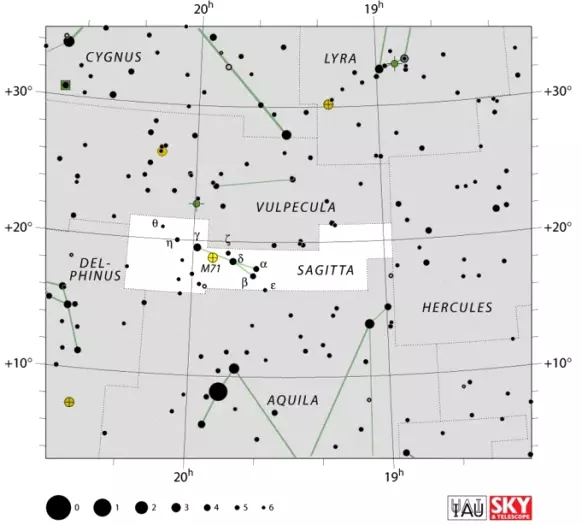
Sagitta constellation map by IAU and Sky&Telescope magazine
Sagitta myth
Sagitta constellation is usually associated with the arrow that Heracles used to strike down the eagle that Zeus sent to gnaw Prometheus’ liver. In mythology, Prometheus moulded men and women out of clay in gods’ likeness, and gave them fire that he had stolen from the gods. Zeus decided to punish him for this, and chained him to Mount Caucasus, where the eagle perpetually gnawed his liver, which would always grow again at night.
The eagle is represented by the neighbouring constellation Aquila. Heracles found Prometheus during one of his journeys, struck the eagle down with an arrow, and freed Prometheus.
In a different myth, Sagitta is identified as the arrow Apollo used on the Cyclopes because they had made the thunderbolts of Zeus that struck down Apollo’s son Asclepius, the famous healer, who is represented by Ophiuchus constellation.
In yet another story, Sagitta is associated with the arrow of Eros which made Zeus fall in love with Ganymede, the shepherd represented by Aquarius constellation. In this story, Zeus’ eagle guards the arrow in the sky.
The Greeks knew the constellation as Oistos, and the Romans later named it Sagitta.
Sagitta stars
γ Sagittae (Gamma Sagittae)
Gamma Sagittae is the brightest star in Sagitta constellation. It is an orange giant with the stellar classification K5III. It has an apparent magnitude of 3.51 and is approximately 274 light years distant from the solar system. The star is about 640 times more luminous than the Sun and has a mass 2.5 times solar.
δ Sagittae (Delta Sagittae)
Delta Sagittae has the stellar classification of M2II+B6. It is a close multiple star system that has a red bright giant for the primary component. The secondary component is a white or blue-white main sequence star in a 3,725 day orbit. The system is approximately 448 light years distant from the Sun and has an apparent magnitude of 3.68. It is 2,800 times more luminous than the Sun.
α Sagittae (Sham – Alpha Sagittae)
Alpha Sagittae is the third brightest star in Sagitta. It is a yellow bright giant with the stellar classification of G1 II. It has an apparent magnitude of 4.39 and is approximately 620 light years distant from Earth. It is 340 times more luminous than the Sun and has a mass four times solar. The star’s radius is about 20 times that of the Sun.
The star’s traditional name, Sham or Alsahm, is derived from the Arabic sahm, which means “the arrow.”
β Sagittae (Beta Sagittae)
Beta Sagittae is a yellow giant star with the stellar classification G8IIIa. It has an apparent magnitude of 4.387 and is approximately 470 light years distant from the solar system. The star has a radius 10 times that of the Sun.
ζ Sagittae (Zeta Sagittae)
Zeta Sagittae is a triple star system in Sagitta. It has an apparent magnitude of 5.01 and is approximately 326 light years distant. The primary component is a white main sequence star with the stellar classification of A3V.
η Sagittae (Eta Sagittae)
Eta Sagittae is an orange giant belonging to the spectral class K2III. It has an apparent magnitude of 5.09 and is approximately 162 light years distant.
ε Sagittae (Epsilon Sagittae)
Epsilon Sagittae is another multiple star system in Sagitta. It has an apparent magnitude of 5.67 and is approximately 473 light years distant from the Sun. The primary star in the system is a yellow giant with the stellar classification G8IIIvar.
15 Sagittae
15 Sagittae is a solar analog in Sagitta. It is a yellow main sequence star with the stellar classification of G0V. It has a visual magnitude of 5.8 and is 57.7 light years distant from Earth.
In 2002, a brown dwarf of the spectral type L4 was discovered orbiting the star in a long-period orbit. It was the first brown dwarf candidate orbiting a solar analog discovered via imaging.
HD 231701
HD 231701 is a yellow-white dwarf belonging to the spectral class F8V. It has a visual magnitude of 8.97 and is 353.6 light years distant from the solar system. In 2007, a Jupiter-like planet was discovered orbiting the star with a period of 142 days.
θ Sagittae (Theta Sagittae)
Theta Sagittae is a multiple star system about 147 light years away in Sagitta. It has an apparent magnitude of 6.51.
The primary star is a yellow-white subgiant with the stellar classification F5IV. It is believed to be about 1.9 billion years old.
S Sagittae
S Sagittae is a Cepheid variable with an F8-G7 spectrum and variations in brightness ranging from 5.5 to 6.2 over a period of 8.38 days. It has a mean apparent magnitude of 5.71 and is approximately 4,289 light years distant from Earth.
U Sagittae
U Sagittae is an Algol-type eclipsing variable. It has the stellar classification B8III + K. It has an apparent magnitude of 6.50 and is approximately 1,012 light years distant from the Sun.
9 Sagittae (QZ Sagittae)
9 Sagittae is a blue supergiant with the stellar classification of O8e. It has an apparent magnitude of 6.24 and an absolute magnitude of -6.95.
The star is 14,174 light years distant from the Sun. It is part of a multiple star system.
Deep sky objects in Sagitta
Messier 71 (M71, NGC 6838)
Messier 71 is a loosely concentrated globular cluster in Sagitta. It has an apparent magnitude of 6.1 and is approximately 13,000 light years distant. The cluster was discovered by the Swiss astronomer Philippe Loys de Chéseaux in 1746. Charles Messier included it in his catalogue in 1780.
M71 spans about 27 light years across and has a luminosity of about 13,200 Suns.
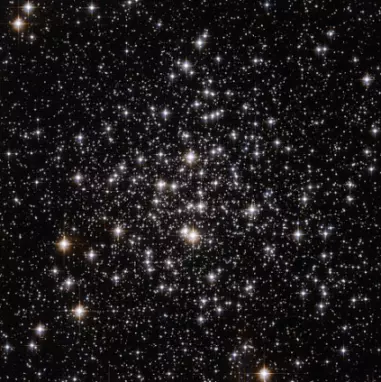
This spectacular NASA/ESA Hubble Space Telescope image shows a bright scattering of stars in the small constellation of Sagitta (the Arrow). This is the centre of the globular cluster Messier 71, a great ball of ancient stars on the edge of our galaxy around 13 000 light-years from Earth. M71 is around 27 light-years across. This picture was created from images taken with the Wide Field Channel of the Advanced Camera for Surveys on Hubble. Image: ESA, Hubble, NASA
Necklace Nebula (PN G054.2-03.4)
The Necklace Nebula is a planetary nebula in Sagitta. It is approximately 15,000 light years distant from the solar system. The nebula was discovered in 2005.
The Necklace Nebula was created when a giant star came too close to its binary companion and engulfed it about 10,000 years ago. The smaller star kept orbiting inside the larger companion and increased the giant’s rotation rate so much that a large portion of its gaseous envelope escaped into space. Most of it escaped along the star’s equator, producing the shape of a necklace.
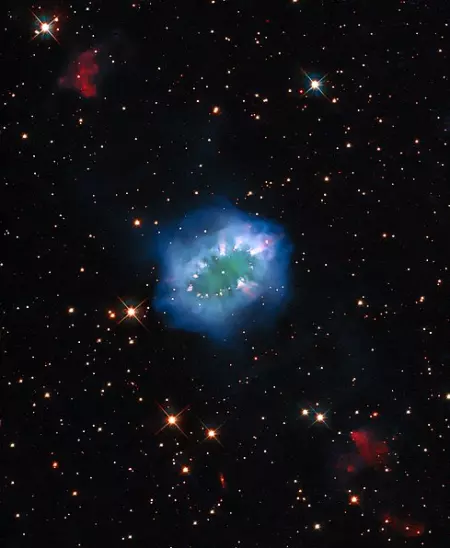
The interaction of two doomed stars has created this spectacular ring adorned with bright clumps of gas — a diamond necklace of cosmic proportions. Fittingly known as the Necklace Nebula, this planetary nebula is located 15 000 light-years away from Earth in the small, dim constellation of Sagitta (The Arrow). The Necklace Nebula — which also goes by the less glamorous name of PN G054.2-03.4 — was produced by a pair of tightly orbiting Sun-like stars. Roughly 10 000 years ago, one of the aging stars expanded and engulfed its smaller companion, creating something astronomers call a “common envelope”. The smaller star continued to orbit inside its larger companion, increasing the bloated giant’s rotation rate until large parts of it spun outwards into space. This escaping ring of debris formed the Necklace Nebula, with particularly dense clumps of gas forming the bright “diamonds” around the ring. The pair of stars which created the Necklace Nebula remain so close together — separated by only a few million kilometres — that they appear as a single bright dot in the centre of this image. Despite their close encounter the stars are still furiously whirling around each other, completing an orbit in just over a day. Image: ESA/Hubble & NASA, K. Noll
NGC 6839
NGC 6839 is not really a deep sky object, but an asterism in Sagitta which was included in the New General Catalogue of Nebulae and Clusters of Stars (NGC). It has an apparent magnitude of 8.4.
NGC 6839 was discovered by William Herschel on August 18, 1784. Sometimes referred to as a cluster, it consists of about 11 stars of magnitude 11 and fainter.
M1-67
M1-67 is a nebula formed by expelled material from the Wolf-Rayet star WR 124. It is almost 6 light years across and expanding at a rate of over 150,000 km/h (100,000 mph), with an estimated dynamical age of 20,000 years.
WR 124 is one of the fastest known runaway stars in the Milky Way, with a radial velocity of about 200 km/s. The star was discovered by the American astronomer and spectroscopy pioneer Paul W. Merrill in 1938. It is classified as an eruptive variable with a range of 0.08 magnitudes. The star was one of the first targets of the James Webb Space Telescope (JWST) in 2022.
The star’s estimated age is only 8.6 million years. Its initial mass was likely around 25 solar masses, but is now only 9 solar masses because the star has blown off a large portion of its material. WR 124 lies at a distance of 10,900 light years from Earth and has a luminosity of 150,000 times that of the Sun. The star’s mean apparent magnitude is 11.50.
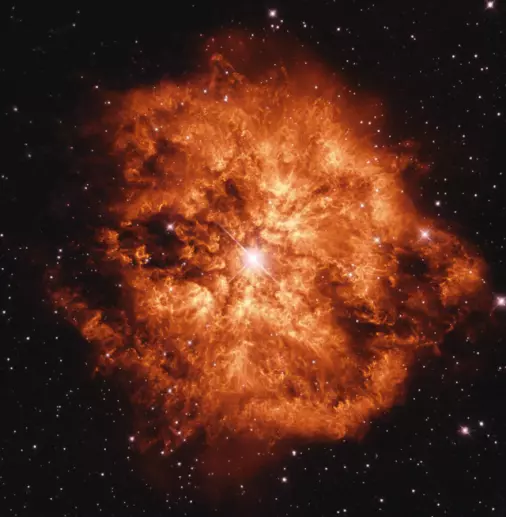
The nebula M1-67 surrounds the star Wolf-Rayet 124. – From the Hubble Legacy Archive. Processing by Judy Schmidt
IC 4997
IC 4997 is a planetary nebula in Sagitta. The nebula has a visual magnitude of 11 and lies at an estimated distance of 8,000 light years from Earth. It expands at a rate of 20 km/s. The nebula is believed to be very young, formed less than 700 years ago.
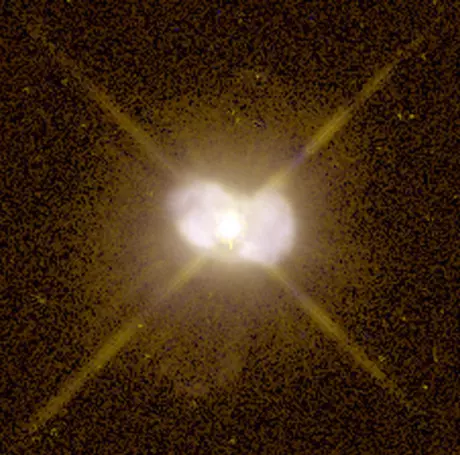
IC 4997 – This image is part of the Hubble Gallery of Planetary Nebulae. Credit: Howard Bond (ST ScI) and NASA/ESA
NGC 6886
NGC 6886 is another planetary nebula found in the constellation. It has an apparent magnitude of 11.8. The nebula’s distance is unknown, but estimated to be in the range from 4,900 to 17,900 light years.
NGC 6886 was discovered by the English astronomer Ralph Copeland on September 17, 1884.
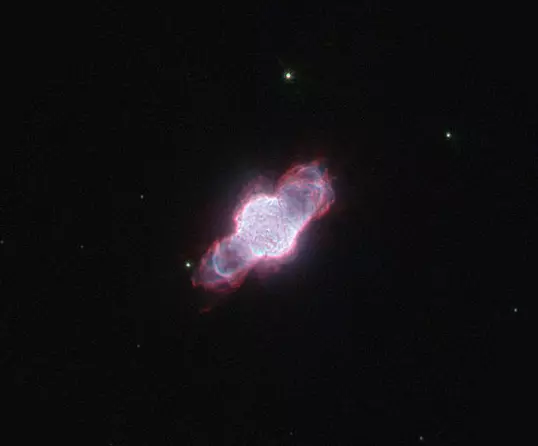
NGC 6886, image: Judy Schmidt (CC BY 2.0)